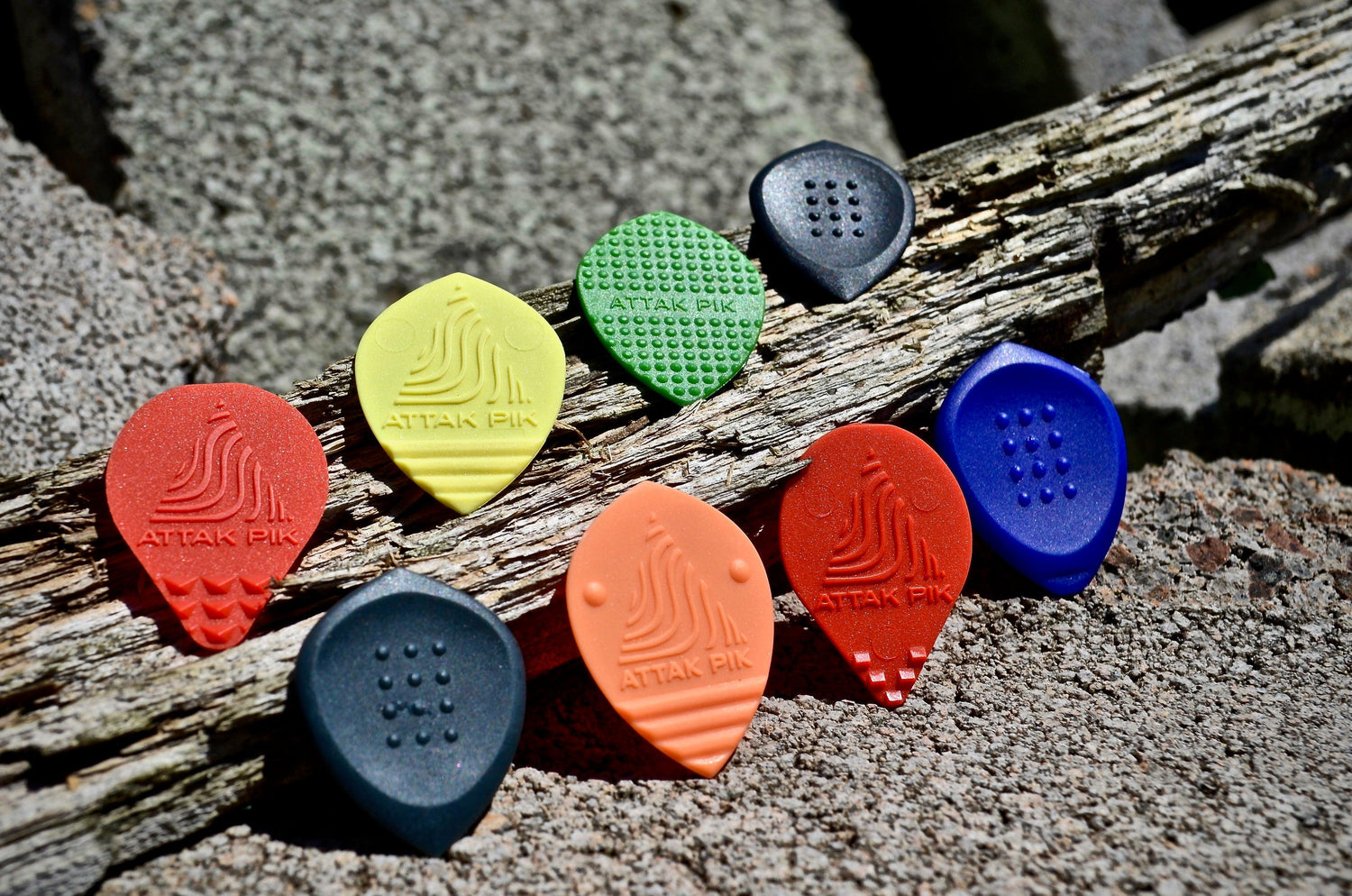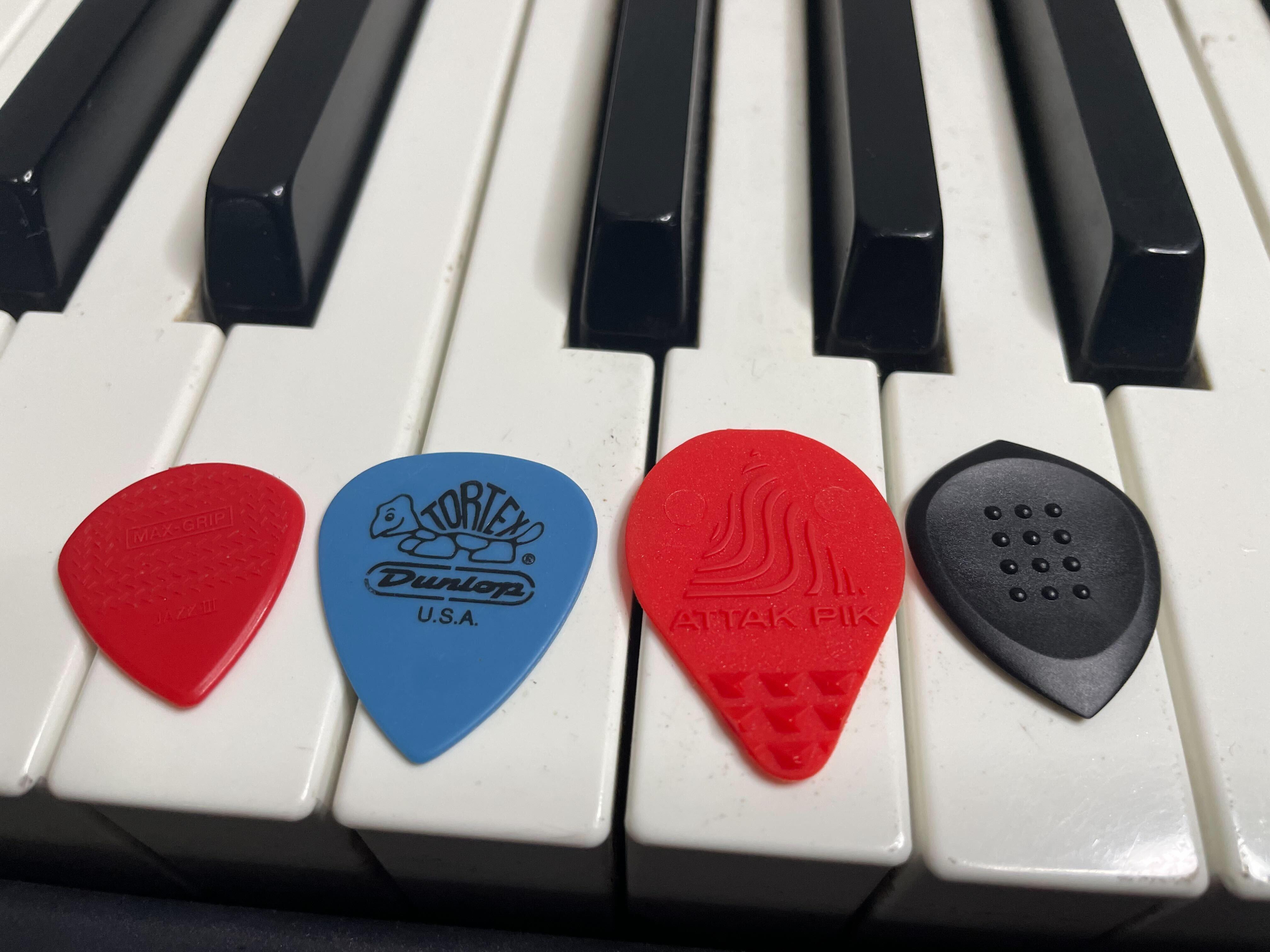Whether you’re brand-new to guitar playing or are a seasoned guitarist, every player can conjure up a memory from their first time playing with a pick. For some, the first memory may be one of triumph — a moment of pride made possible by mastering your first complex picking pattern.
Others, however, may be transported back to a moment of utter frustration as they fumbled their pick in their fingers and listened as it slipped between the strings and clattered around the sound chamber. If you count yourself among the latter, it’s possible that your aggravation was caused more from choosing the wrong pick than from lack of experience.
Knowing what to look for when choosing the right guitar pick is half the battle and can help you fine-tune your sound and set your pick playing apart from the rest. In this blog, we help players understand how to choose the right guitar pick for their needs. We’ll cover:

- Benefits of Using a Guitar Pick
- Different Types of Guitar Picks
- The Best Guitar Picks for Acoustic Guitarists
- The Best Guitar Picks for Electric Guitarists
- The Best Guitar Picks for Bass Guitarists
- Things to Consider When Choosing a Guitar Pick
- Why Choose a Textured Guitar Pick?
- Where to Find the Right Guitar Pick
Benefits of Using a Guitar Pick
A pick is an important tool in any guitarist’s arsenal. From strumming different chords to bending strings and playing powerful solos — a guitar pick is your primary means of creating sound and breathing life into your instrument.
Using a guitar pick opens you up to new playing techniques — ones that would be difficult to master with your bare fingers. With a pick in hand, you now have the opportunity to play a range of riffs and complex chords, producing different sounds in different situations.
It is the pick that enables your musical expression; it adds character and color to your sound. However, it is you and you alone who possesses the power to master the craft. Knowing what pick is best for your playing style is the perfect place to start.
Different Types of Guitar Picks
Before we dive into the nitty gritty of guitar pick selection, let’s do a brief overview of the most popular picks for different playing styles and specialties.
 The Best Picks For Acoustic Guitarists
The Best Picks For Acoustic Guitarists
Ask pretty much any acoustic guitarist and they’ll probably tell you that they prefer picks with a little flexibility and give when they strike the strings. This is because a flexible pick moves easily across the strings and enables the player to create that fulsome and distinctive rhythm tone that lies at the heart of folk and country music.
If you’re looking to bring out tones reminiscent of a 12-string, the Attak Pik from Acoustik Attak is the way to go, offering a percussive, “double-striking” effect. This textured pick harmonically enhances mid-range frequencies while smoothing out the individual string volumes on open chords. The result is a crisp and clear delivery of each and every note.
The Best Picks For Electric Guitarists
 If electric guitar is your jam, you’ll want a pick that delivers clarity and packs a punch — especially for live performances. That said, Acoustik Attak has two great options for you to ‘pick’ from:
If electric guitar is your jam, you’ll want a pick that delivers clarity and packs a punch — especially for live performances. That said, Acoustik Attak has two great options for you to ‘pick’ from:
First up is the Blade Pick. This pick produces a compressed sound when picking individual notes, allowing overdrive and distortion effects to cut through the mix with more clarity. Simultaneously, the pick mitigates the muddiness of excess string resonance in the lower-frequency range.
The Stealth is the true “shredders pick” with a pointed tip that allows for unmatched precision in attack for speed picking, tremolo (alternate picking), and sweep picking. Giving a slightly cleaner tone, Stealth shines in its ergonomic design. The center is concave with raised bumps to lock the thumb in and avoid slippage, so you can rock out without losing the pick across the stage!
The Best Picks For Bass Guitarists
 Last but not least, the best picks for the boss bassists out there. Bass strings are typically much thicker than standard guitar strings, so you’ll want to find a pick that gives you the most control when plucking them. That said, you’ll also want a pick that adds some roundness to your tone.
Last but not least, the best picks for the boss bassists out there. Bass strings are typically much thicker than standard guitar strings, so you’ll want to find a pick that gives you the most control when plucking them. That said, you’ll also want a pick that adds some roundness to your tone.
In this case, a pick that’s too flexible won’t offer the kind of consistency and clarity that bass playing requires. With a sturdier pick, like the Juggernaut, you’ll get a thumping 3mm power with precise accuracy (1mm tip) on the attack of each note.
The second option is the Ambush Pick. This pick creates a bright, percussive, strong sound that’s guaranteed to make an impact. The raised structures allow for some snag but less-so on the higher gauge bass strings, which gives a “slap and pop” effect.
The Surge pick produces similar percussive elements as the Attak and Ambush, resulting in an edgy, growling, yet beautiful tone on bass.
As you can see, there’s a diverse range of guitar picks available on the market, so guitarists with various styles and playing preferences can find a one that best suits their sound.
Things to Consider When Choosing a Guitar Pick
Now that you understand what different types of guitar picks are available, it’s time to dive into what to consider when shopping for the right guitar pick for your specific needs. Below are just some of the most important things to consider when choosing the right pick:
Size
The size of the pick itself will impact how comfortable you feel while you’re playing. If you’re someone with smaller hands, you’ll probably prefer to use a smaller pick because it will bring your strumming hand closer to the strings and make it easier to alternate between different playing techniques. By contrast, if you have larger hands, a bigger pick is best since they’re harder to drop or fumble between your fingers.
Thickness
The thickness of a guitar pick determines its overall durability and the kind of sound it creates. Generally speaking, guitar picks come in one of four different gauges:
- Thin: 0.40mm to 0.60mm thick
- Medium: 0.60mm to 0.80mm thick
- Thick: 0.80mm to 1.20mm thick
- Extra Thick: 1.20mm+ thick
Thick picks are stiffer, heavier, and more durable than thin ones (which are more flexible in nature). Guitarists using thicker picks can easily attack the strings and produce a stronger, more distinct tone. However, some guitarists prefer thin picks because they’re easier to use when strumming chords and flying through different picking techniques.
If you’re feeling adventurous, you can try using two different kinds of picks at once — a thick one for digging into individual notes, and a thin one for strumming. Consider recording your sessions as you experiment and practice with different picks. Later, when you’re resting your fingers, you can play back the audio to see how different picks impact your tone and enhance your overall sound.
Material
The final factor to consider is the guitar pick’s material. While celluloid, nylon, and delrin are most commonly used, many guitar picks available on the market are made from other materials — such as wood, metal, acrylic, and stone.
As you can likely imagine, different materials will wear down at different rates depending on how often you use them and how aggressively you play. For example, certain materials like celluloids aren’t as durable as nylon, so they won’t last as long as you might like.
Although the choice of material is mostly based on your own personal preference, there are two specific elements you’ll want to take into account as you deliberate: texture and tone.
Why Choose a Textured Guitar Pick?
There are two main reasons why a textured guitar pick offers a better playing experience: grip and sound. Different materials have different textures and, naturally, you’ll want to find a pick that feels good between your fingers while also offering the best quality sound.
Picks made of materials like celluloid are smooth in texture. They often have a polished shine that makes them look great, but feel slippery. So if you’re prone to sweating on stage — or anywhere else you prefer to play — you may find your pick sliding from your fingertips and ruining your riff.
Alternatively, textured picks — like those made of nylon — have a coarser surface and create more friction between your fingertips. This makes them much easier to grip than smooth picks, and far less likely to slip from your grasp during an intense jam session.
At the same time, it’s important to consider how these various textures will generate different sounds and impact your tone as you play. Smoother picks typically produce a softer sound. They slide smoothly across the strings and create that soft and well-rounded tone that so many musicians know and love.
Textured picks, on the other hand, generate a colorful, complex, and defined sound that really stands out. For instance, Acoustik Attak produces picks with ridges, bumps, and other raised structures on their attack zone tips. With just a single pluck of a string, these textures create a pattern of multiple strikes, echoing out in a series of sound waves at different times. The result of these textures is brighter tones, desirable harmonics, percussive effects, and different frequencies that flat picks simply can’t deliver.
Where to Find the Right Guitar Pick
A guitar pick is an essential piece of equipment — one that can greatly enhance your performance and help you refine your sound. While different factors such as shape, size, thickness and material will influence your decision, choosing the best guitar pick ultimately comes down to personal preferences and playing style.
Whether you’re an acoustic guitarist who prefers flexible picks and fulsome tone, or a bassist looking for a sturdy pick and strong sound, the selection available from Acoustik Attak will exceed all of your musical expectations. Find the right guitar pick for your experience level, playing preference, and style by shopping Acoustik Attak online today!



Leave a comment
All comments are moderated before being published.
This site is protected by hCaptcha and the hCaptcha Privacy Policy and Terms of Service apply.